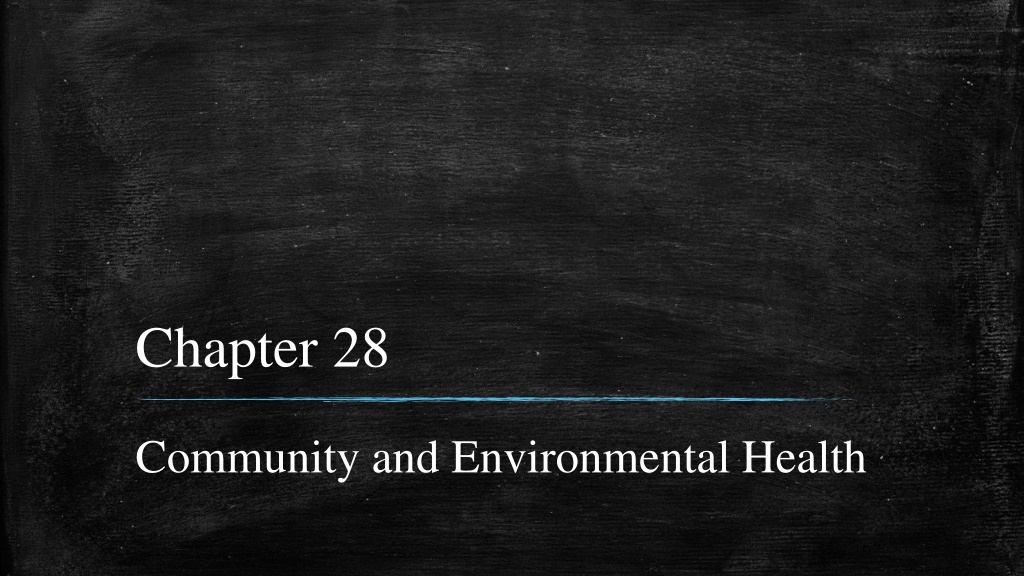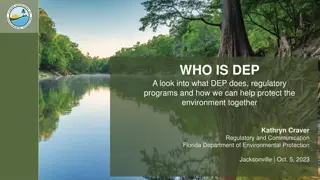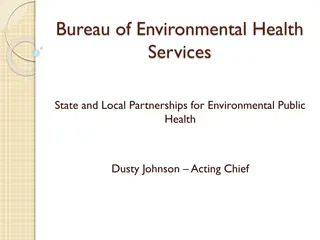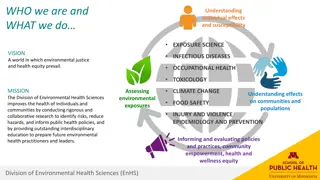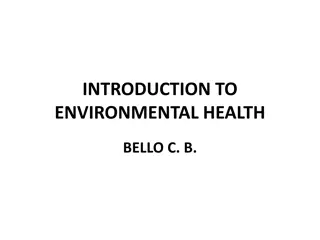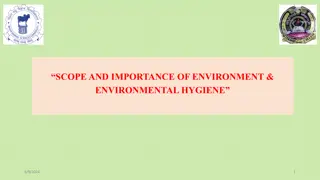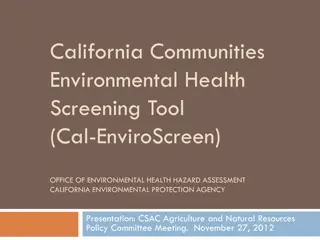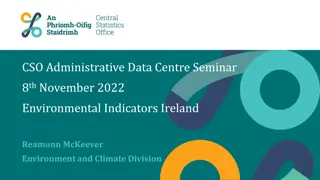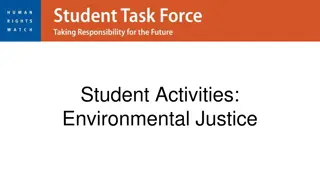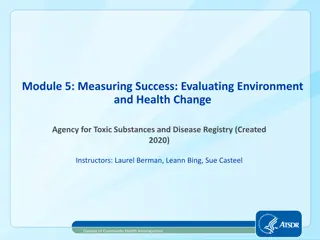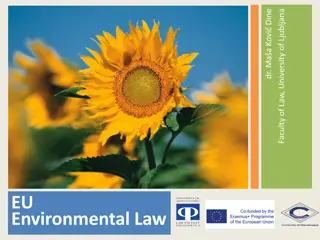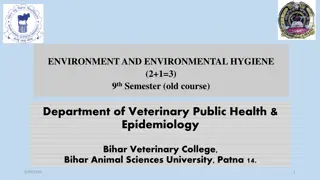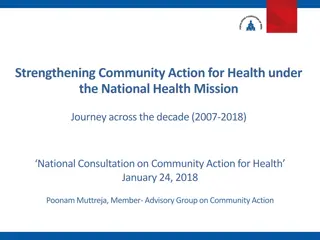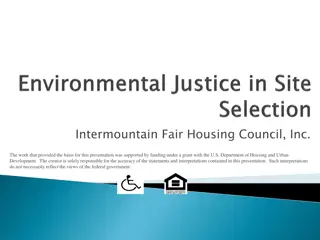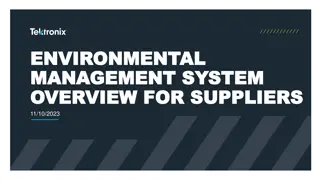Understanding Community and Environmental Health
Explore the realm of community and environmental health, including types of health care facilities, taking responsibility for your health, the role of health agencies at local, state, and national levels, and the impact of global health organizations. Learn how different entities work towards promoting public health and ensuring the well-being of communities globally.
Download Presentation

Please find below an Image/Link to download the presentation.
The content on the website is provided AS IS for your information and personal use only. It may not be sold, licensed, or shared on other websites without obtaining consent from the author. Download presentation by click this link. If you encounter any issues during the download, it is possible that the publisher has removed the file from their server.
E N D
Presentation Transcript
Chapter 28 Community and Environmental Health
Lesson 1 Community and Public Health The Health Care System Primary care physician check-ups and general care. School nurse anything that happens while you are school. Dentist examines teeth. Specialist focuses on certain kinds of conditions. What are some types of health care facilities? Out patient care treated and return home the same day. Inpatient care patient must stay overnight.
Urgent illnesses/injuries treated at an emergency room. Non-life threatening problems treated at urgent care. (open evenings and weekends) Birthing center. Drug treatment center. Assisted living facilities. Hospice. How can you take responsibility for your own health? Take an active role. Be aware of your medical history.
Any health conditions you now have. Health conditions you ve had in the past. All medicines you are taking. Any allergies you have. Health problems that run in the family. Your lifestyle and habits. HEALTH INSURANCE LESSON Public Health Services Health issues that affect your whole community.
Local, state, and national agencies work to make communities healthier by: Researching health problems. Providing health services. Educating the public. Developing and enforcing policies that promote health. How do local health agencies promote health? They promote public health by: Investigating threats to public health. Plan responses to public health emergencies. Enforcing local health policies. Providing information about health issues.
How do national health agencies promote public health? Educate public about diseases/other health issues. Fund research into new treatments to fight disease. Several departments of the U.S. government also promote public health: The Environmental Protection Agency The Occupational Safety and Health Administration The U.S. Department of Agriculture The Federal Trade Commission The Department of Health and Human Services
How do global health organizations promote public health? Organizations include: The World Health Organization The United Nations Children s Fund The International Committee of the Red Cross The U.S. Agency for International Development The Peace Corps Cooperative for Assistance and Relief Everywhere
Lesson 1- Discussion Questions 1. What is the difference between a primary care physician and a specialist? 2. List three types of health care facilities. 3. Identify two organizations that work to promote global health.
Lesson 2 Air Quality and Health Understanding Air Pollution Normally you can t see it, but it is all around you. Linked to many health problems. Examples include: Lung disease, cardiovascular disease, and cancer. What affects air quality? EPA has placed limits in levels of six pollutants that harm human health and the environment. These include: Ozone Particulate Matter
Carbon monoxide Sulfur dioxide Nitrogen oxides Lead AQI is used to inform the public about the local air quality. What are greenhouse gases? Greenhouse effect trapping of heat by gases in the earth s atmosphere. Gases that allow sunlight to enter the atmosphere. Block heat from escaping.
Main greenhouse gas we produce is carbon dioxide. Burning of fossil fuels causes most of the CO2 . Without the greenhouse effect the planet would be too cold to support life. In the past 200 years factories have produced more greenhouse gases. Gases become trapped in atmosphere and warm the earth. Increase in temperature is global warming.
What are some sources of indoor air pollution? Common indoor air pollutants include: Carbon monoxide Asbestos Radon Reducing Air Pollution Power plants and home heating systems are sources of air pollution. Here are some tips for saving energy: Switch off lights anytime you leave a room.
Turn off radios, computers, televisions, and other appliances when they are not in use. In the winter, keep the thermostat at around 68 degrees. Insulate your home to reduce your need for heating and cooling. Wash clothes in warm or cold rather than hot water. When cooking, do not preheat the oven longer than necessary. Try walking, riding a bicycle, or use public transportation.
How can you manage indoor air pollution? Identify sources of pollution and get rid of them. Home test kits and detectors can help measure levels. May need professional help to eliminate pollution sources. Noise Pollution Sources include: Traffic Loud music Power tools
Over time noise exposure can lead to hearing loss. May experience ringing in the ears. Most cases normal hearing returns after noise stops.
Lesson 2 Assessment Questions 1. Name the six outdoor air pollutants for which the EPA sets limits. 2. How is radon harmful to human health? 3. What might result from repeated exposure to to sounds of 90 decibels or louder?
Lesson 3 Protecting Land and Water Waste Disposal Waste can be biodegradable or non-biodegradable. Waste needs to be disposed of in ways that will not damage land and water. How can we dispose of solid waste? Municipal solid waste is another term for trash. There are two ways to dispose of MSW: Landfills Incineration How can we dispose of hazardous waste?
Types of hazardous waste include: Industrial wastes. Household wastes. Radioactive wastes. Mercury. Problems of Development As population grows, so does our use of resources. Development can affect the environment in several ways. How do disappearing forests affect the environment?
It destroys the habitats of plant and animal species. Some have even become extinct. The loss of trees puts these areas at risk for soil erosion and flooding. It alters the local climate, making it hotter and drier. It contributes to global warming. How does urban sprawl affect the environment? Paved areas do not filter rainwater the way soil does. Destroy wildlife habitats and reduce air quality. To combat these problems, city planners are using a concept called smart growth.
Use fewer resources and create less pollution. Everything is built close together so people can walk from place to place. Preserve open land and provide more transit choices. Water: A Limited Resource The EPA protects the water supply in the US. Sets standards for the quality of drinking water. Protects oceans, rivers, and other water systems. What are some sources of water pollution? Runoff. Wastewater.
Sediment. Oil. Protecting the Environment Here are some useful steps: Repair leaky faucets. Wait until you have a full load before doing laundry or running the dishwasher. Install low-flow showerheads, faucet aerators, and low-flush toilets. Do not over water your lawn or garden. Follow directions when using household chemicals. Dispose of all hazardous waste properly.
How can you reduce waste? Practice the three R s: Reduce. Reuse. Recycle.
Lesson 3 Assessment Questions 1. Name four types of hazardous wastes? 2. How can wastewater harm the environment? 3. What is the difference between reuse and recycle?
